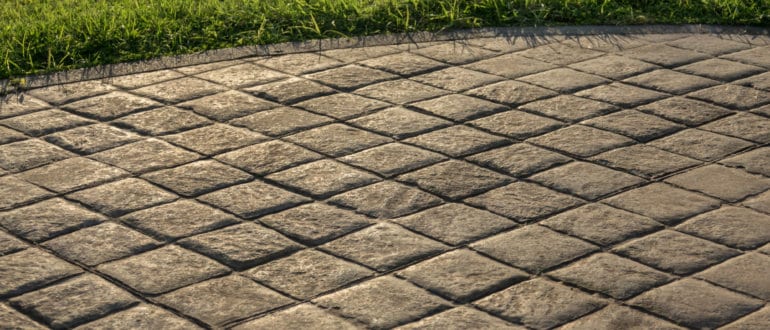Do you want to know how stamped concrete works? We’re here for you!
Stamped concrete is a great option for paving surfaces like patios, walkways, driveways, and more. It can look like natural materials such as stone, brick, or wood, but it is much more durable and resistant to wear and tear.
Stamped concrete works by imprinting patterns and textures on wet concrete before it hardens. This way, you can create a beautiful and long-lasting surface that suits your style and budget.
Let’s read on to find out explicitly how stamped concrete works.

Table of contents
What Is Stamped Concrete?
Stamped concrete is a type of concrete that has been customized to look like other materials. You can choose from a variety of colors, patterns, and textures to create a surface that matches your preferences and needs.
Stamped concrete works by applying color and stamping molds to fresh concrete before it sets. This way, you can achieve a realistic and attractive appearance that mimics brick, stone, tile, or even wood. Stamped concrete is a good choice for many reasons, such as:
· It is durable and easy to maintain. Unlike other materials, stamped concrete does not crack, chip, fade, or warp over time. It also resists stains, mold, and weeds. You only need to seal it every few years to keep it looking new.
- It is versatile and adaptable. You can use stamped concrete for any type of surface, such as patios, walkways, driveways, pool decks, and more. You can also customize it to fit any shape, size, or slope of your area. You can even combine it with other materials, such as pavers, stones, or plants, to create a unique design.
- It is cost-effective and eco-friendly. Stamped concrete is usually cheaper than the materials it imitates, especially in the long run. It also saves you money on installation, labor, and maintenance costs. Stamped concrete is also environmentally friendly, as it uses less natural resources, reduces waste, and lowers emissions.
See also: What Is Construction Consulting? Know This Before Engaging A Firm
Styles of Stamped Concrete
Stamped concrete is a versatile technique that can transform the appearance of any concrete surface. It involves using rubber stamps or texturizing mats to create patterns and textures on wet cement. These stamps can mimic the look of natural materials, such as brick, stone, wood, and more.
You can also add custom features, such as medallions or logos, to personalize your concrete slab. Stamped concrete can be used on both new and existing concrete, as long as the slab is in good condition. You can also apply it on horizontal or vertical surfaces, which opens up many possibilities for your projects.
For example, you can use stamped concrete to enhance an outdoor fireplace, a retaining wall, or a garden path. Stamped concrete is not only for outdoor use. You can also use it indoors to create durable and attractive floors. You can stamp your concrete basement floor to look like wood planks, or your kitchen floor to look like tile.
However, stamped concrete can be cold and hard underfoot, so you may want to use area rugs for comfort and warmth.
See also: How Does a Master Key Work on Various Doors?
How to Stamp Concrete
Stamping fresh concrete requires good timing. The concrete should be neither too soft nor too hard for the stamps to work.
If it is too soft, it will sag under the workers’ weight and the texture will be blurry. If it is too hard, it will resist the stamps and the texture will be faint.
That is why you should hire a professional contractor, who will know when the concrete is ready for stamping, to install your stamped concrete. Stamping is usually done on new concrete. A new slab is shaped and poured and a stamping team comes in soon after to add texture.
Here are the main steps of the stamping process:
#1. Apply Color Hardener

Color hardener is a product that adds color and strength to the surface of the concrete. It is sprinkled by hand and then smoothed into the surface using a tool called a bull float.
This is not a necessary step. You can skip the color hardener if you want to color your stamped concrete in other ways, such as using integral color or applying concrete stains or dyes after the concrete has cured.
#2. Apply Release Agent

A release agent is a product that prevents rubber stamping mats from sticking to the concrete, similar to how no-stick cooking spray works. It comes in two forms, powder, and liquid, and it should be applied right before stamping.
See also: 20 Construction Certifications Online | Free And Paid
#3. Check Concrete’s Plasticity
To achieve the best texture and detail, stamping should be done when the concrete is at the right stage. Most contractors test the concrete by pressing their fingers or by placing one stamp and checking that it can support their weight and produce a good result.
The concrete should be firm enough to hold the stamp’s impression, but soft enough to allow the stamp to penetrate without too much force. The ideal stage may vary depending on the type of concrete, the weather, and the stamping pattern.
#4. Create Texture on the Edges of the Slab

This step makes sure that the edges have the same texture as the rest of the concrete. A texturing skin or flex mat is used because it can bend and fit along the edge of the form. This way, the edge will not look smooth or plain compared to the stamped surface.
See also: How Does Paypal Goods And Services Work
#5. Start Placing Stamp Mats

The stamping crew will start by placing one or two rows of stamps, starting from the part of the slab that was poured first. The installers will stand on top of the mats to make sure that the texture is transferred.
The first row is very important because it sets the pattern for the whole project. It must be aligned straight and parallel to the edge of the slab.
#6. Continue Placing Stamps
The crew will stand on the first mats and place more mats in another row. This process is sometimes called leapfrogging.
Most contractors do not have enough stamps to cover the whole patio or driveway, so they move stamps that have been applied and pressed to new positions to continue the pattern.
The crew will make sure that the mats are aligned and overlapped correctly to avoid gaps or seams. They will also use hand tools to stamp the edges and corners that the mats cannot reach.
See also: GoAnimate For Schools: How Does It Work | Pros and Cons
#7. Fix Any Imperfections
Sometimes, some textures may not come out as clearly as you want. Your contractor can use hand tools to fix any flaws.
They can smooth out any blurred pattern lines or cement paste that rises between the joints. This can be done easily as long as the concrete is still soft and not hardened.
#8. Clean the Surface and Apply Curing Compound

Depending on the type of release agent used, your contractor may need to wash off the excess from the surface and wait for a few days before applying a curing compound. The release agent is a product that prevents the stamps from sticking to the concrete.
The curing compound is a product that helps the concrete harden and develop strength. It is important to follow the manufacturer’s instructions for both products to ensure the best results.
See also: How Does AT&T Student Discount Work?
#9.

Control joints are essential in all concrete, including stamped, to prevent random cracking. They are grooves or cuts that create weak points in the concrete, allowing it to crack in a controlled manner.
Joints can be made with a groover tool before the concrete sets or with a saw and diamond blade after the concrete sets. Joints should be spaced and placed according to the size and shape of the slab and the pattern of the stamps.
#10. Seal the Concrete

To prevent stains and other problems, you should apply a sealer to your concrete. You need to wait for a few weeks after stamping before applying it so that the concrete is completely cured.
The whole process of stamped concrete takes a few weeks, including sealing. However, most of the work is done in just a few days (forming, pouring, and stamping). You should ask your contractor how long you need to wait before using your new patio, driveway, or walkway, as this can vary depending on the weather and other factors.
The number of installers working on your concrete can range from as few as three to more than eight, depending on the size and the detail of the job. Usually, more installers are better, because they can work faster and stamp the concrete at the best time. You may want to ask the contractor you are considering how many people are on his or her crew.
See also: How Does DUI Classes Work? Cost, Schools, and Procedures
Pros and Cons of Stamped Concrete
The selection of flooring materials is extensive. So, is this project a good fit for stamped concrete? Its durability and strength are its key advantages, and customization options abound. Additionally, it can be made into a secure, non-slip surface by applying texture or another non-skid additive. Although stamped concrete is typically less expensive than brick or stone, it is still a design element that can improve the value of your house.
One drawback of stamped concrete is that it usually requires a certain level of expertise, so DIY projects are not possible. In order to maintain the best possible appearance, concrete should also be resealed every two to five years. Additionally, it can be challenging to fix any cracks in the concrete, and you might not be able to match the stamped pattern to the rest of the slab.
See also: How Does Amazon Wish List Work?
Stamped Concrete vs. Other Materials
Similar to stamped concrete, other well-liked materials like bricks and stones also look fantastic and raise the property value.
Additionally, they are useful for covering uneven ground because they create a surface made up of several interlocking pieces. Pouring level concrete over an uneven surface can be challenging.
Nothing should be able to grow through concrete, yet weeds frequently appear in the gaps between pavers.
See also: How Does College Accreditation Work?
FAQs
The stamping process uses rubber stamps or texturizing mats to imprint a pattern into wet cement. There are also ways to apply it over existing concrete if your slab is in good shape. These stamps are often designed from molds of the real material to get the appropriate texture.
Provided it’s installed correctly and adequately maintained, stamped concrete will last just as long as non-stamped, or standard, concrete—about 25 years. That’s because the processes of installing stamped concrete and standard concrete are mostly the same.
This isn’t unique to stamped concrete – any poured concrete will crack and move over time when exposed to freezing and thawing cycles.
One of the main reasons for cracked concrete is shrinkage because when the concrete hardens and dries, it shrinks. Stamped concrete cracks can start little by little, so it will be difficult to identify them initially. Sometimes repairing the damage is as easy as replacing some pavers or chipped stones.
Most all stamped concrete will have areas that hold some water, due to either the texture of stamp impressions or combined with a bird bath here and there.
Conclusion
In the end, everything depends on the viewer. The way stamped concrete works is never going to be confused with the actual material it is designed to resemble, be it wood, tile, stone, or bricks.
And that’s a deal-breaker for certain people. Stamped concrete can be the answer if you’re looking for a material that requires less upkeep and is more durable than the real thing.
References
- Thespruce.com – Process and Uses for Stamped Concrete
- Landscapingnetwork.com – How To Stamp Concrete
Recommendations
- Barry’s Bootcamp Reviews: How does it work | Host Opinion
- What Does a Construction Management Career Path Looks Like?
- Top 10 construction certifications in the World | 2024
- Construction Engineering vs Civil Engineering: Salary, Job Outlooks, Requirements
- 15 Best Jobs in a Construction Company in 2024





